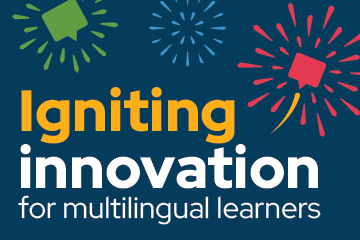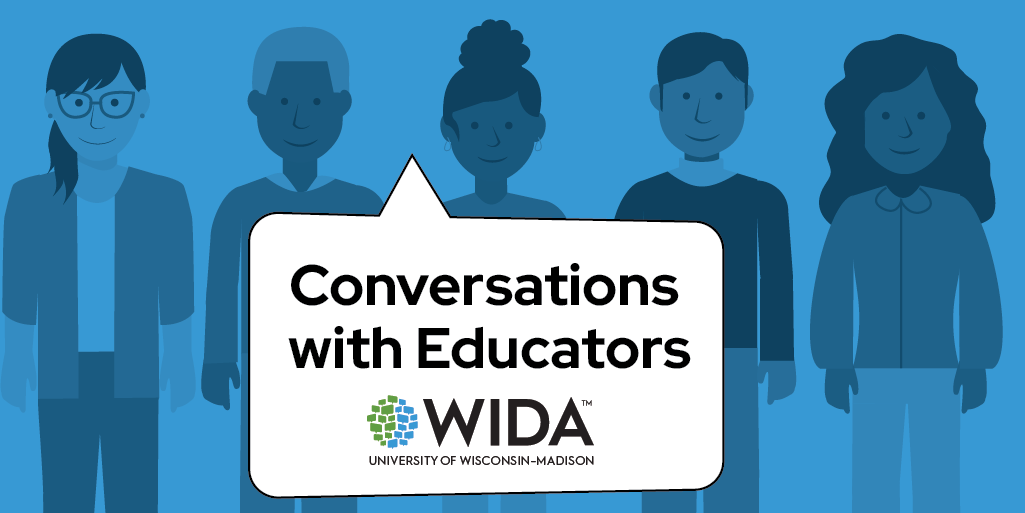Resources/Recursos
Featured Resources



All resources/Todos los recursos
Filter resources by:
Resources/Recursos
The Marco ALE de WIDA: A sociocultural approach to the creation of Spanish language arts standards
This WIDA Snapshot introduces the Marco de referencia de las artes del lenguaje del español de WIDA: Aplicación para la actualización y desarrollo de estándares (Marco ALE). The Marco ALE is a Spanish language arts framework and is designed to support the development of Spanish language arts standards specifically for educational settings in the United States.
Resource DetailsReleased May 2025
El Marco ALE de WIDA: un enfoque sociocultural para la creación de estándares de las artes del lenguaje del español
Este resumen informativo de WIDA presenta el Marco de referencia de las artes del lenguaje de español de WIDA: Aplicación para la actualización y desarrollo de estándares (Marco ALE). El Marco ALE es diseñado para apoyar la creación de estándares de las artes del lenguaje del español específicamente para entornos educativos en los Estados Unidos.
Resource DetailsReleased May 2025
Examining English Learner Testing, Proficiency, and Growth: Continued Trends since the COVID-19 Pandemic
This report examines English learners’ testing, proficiency, and growth during the six most recent academic years (2018-2023) to shed light on the continued impact of the COVID-19 pandemic on English learners’ educational outcomes. It provides descriptive evidence on disparities in outcomes within WIDA's English learner population, with substantial average differences in outcomes between English learners identified as Hispanic compared to non-Hispanic ELs. Findings show that these disparities are persistent and have been exacerbated by the COVID-19 pandemic.
Published April 2024
Authors: Glenn Poole, Narek Sahakyan
Released April 2024
District Level Analysis of ELL Growth
This research project explored the patterns of district-level ELL “growth” for the 2007-2011 time period and identified the existence of “high-flying” and “low-cruising” districts within ACCESS for ELLs in terms of ELL growth.
Published May 2013
Author: Narek Sahakyan
Resource Details View Download Now
Released May 2023
Examining English Learner Testing, Proficiency, and Growth: Before, During, and “After” the COVID-19 Pandemic
This report examines English learner testing, proficiency, and growth in the years surrounding the COVID-19 pandemic. This research builds on an October 2021 report on the impact of the pandemic, and includes data from the 2021-22 ACCESS for ELLs test administration. Findings indicate that in some grades and language domains EL's average proficiency and growth have returned to pre-pandemic levels. However, for most grades and language domains the evidence points to a continuing impact of COVID-19 on English learners’ English language development.
Published April 2023
Author: Narek Sahakyan, Glenn Poole
Released April 2023
Examining Growth at the Intersection of IEP and (Long-Term) EL Status
Motivated by findings of a 2018 WIDA report pointing to large overlap between ELs with Individualized Education Program (IEP) designations and those ELs who could be identified as LTELs, this study further focuses on these dual-identified students. Grouping ELs by ever-IEP (i.e., being assigned an IEP at any point in the longitudinal record) and never-IEP status, we compare these two subgroups’ English language growth trajectories across time. Our findings show consistent trends of differential growth and reclassification rates for these two subgroups.
Published November 2021
Authors: Narek Sahakyan, Glenn Poole
Released November 2021
Examining English Learner Testing, Proficiency and Growth: Before and Throughout the COVID-19 Pandemic
This report examines English learners’ (EL) testing, proficiency and growth in the academic years of 2018–19, 2019–20 and 2020–21, using population-level data from ACCESS for ELLs Online, administered across the WIDA Consortium to students identified as ELs. The objective of the report is to shed light on the impact of the COVID-19 pandemic on ELs’ educational outcomes.
October 2021
Authors: Narek Sahakyan, H. Gary Cook
Released October 2021
Putting It All Together: Next Steps for Using the 2020 Edition
In this webinar, the WIDA standards development team discusses and models the tools, provided in the 2020 Edition, for initiating critical conversations with school leaders and colleagues.
Resource DetailsReleased March 2021
Introduction to the Updated Key Language Uses
One of the components of the WIDA ELD Standards Framework is the Key Language Uses (KLUs). The KLUs summarize the most prominent language uses across disciplines, helping educators organize and prioritize curriculum and instruction. Learn about the updated KLUs – Inform, Narrate, Explain and Argue.
Resource DetailsReleased February 2021
Introduction to the 2020 Edition
Members of the WIDA standards development team share a high-level overview of what’s new and exciting in the WIDA English Language Development Standards Framework, 2020 Edition. Intended for SEA representatives, district leaders, and EL and content teachers.
Resource DetailsReleased January 2021
Generating Imputed Overall Composite Scale Scores for English Learners with Disabilities Who Are Missing Domain Scores in the ACCESS for ELLs Assessment
This technical report aids WIDA Consortium members and stakeholders in producing imputed overall composite scale scores and proficiency levels for students who are missing scores in one or two domains due to a disability.
Published September 2020
Author: Narek Sahakyan
Released September 2020
Examining the Relationship Between the WIDA Screener and ACCESS for ELLs Assessments
This report describes a study that examined to what extent scores on WIDA Screener predict scores on ACCESS for ELLs. Researchers found that Screener scores are strongly predictive of ACCESS scores, even when a variety of individual factors are accounted for.
Published February 2020
Authors: David MacGregor, Narek Sarakyan
Released February 2020
Less Than Four Domains: Creating an Overall Composite Score as an Indicator of English Language Proficiency for English Learners with 504 or Individualized Education Plans
The illustrated models and procedures can be applied to calculate overall composite scores to identify an indicator of English language proficiency, based on composite scores for English learners with 504 or individualized education plans who are missing one or more domain scores on the Assessing Comprehension and Communication in English State-to-State for English Language Learners assessment for state monitoring, achievement and accountability determinations.
Resource DetailsReleased May 2019
Less Than Four Domains: Creating an Overall Composite Score for English Learners with Individualized Education Plans
The analysis in this report illustrates models and procedures that can be used to assign a missing domain score in order to calculate an overall composite score. These methods only apply to assessments taken by English learners whose IEPs or 504 plans require they not be tested in one or more domains.
Resource Details View Download NowReleased March 2019
Exploring the Long-term English Learner Population Across 15 WIDA States
This research report summarizes findings from a recent WIDA study exploring the potential long-term English learner (LTEL) population across 15 geographically-representative WIDA member states during the period 2009-10 through 2014-15. The findings highlight a continuing need for research that rejects an overly simplistic understanding of the LTEL designation. Additionally, future research should more carefully examine how educational systems, practices, and policies structure the experiences and diverse trajectories of students identified as LTELs.
Published October 2018
Authors: Narek Sarakyan and Sarah Ryan
Released October 2018
Including Recently Arrived English Learners in State Accountability Systems: An Empirical Illustration of Models
Based on a U.S. Department of Education guide, these model analyses illustrate procedures a state could use to compare and contrast school-level overall and English learner accountability determinations for proficiency in reading/language arts. These examples are provided only to illustrate how a state could undertake them as part of its efforts to develop and explore a theory of action for assessment of recently arrived English learners.
Resource DetailsReleased March 2017
Evaluating Teacher Effectiveness Using ACCESS for ELLs
Regardless of the growth model, aggregate test-score-based models of student growth require large and longitudinally connected samples of student data. When sample sizes are small it becomes impossible to reliably estimate and disentangle district, school and teacher effects from student growth data.
Published June 2015
Author: Narek Sahakyan
Released June 2015
Examining District-Level Growth Using ACCESS for ELLs
This research report provides a description of a study examining school districts in the WIDA Consortium whose English language learners (ELLs) exhibit consistently high growth on the ACCESS for ELLs (ACCESS) assessment.
Published August 2014
Authors: Narek Sahakyan, H. Gary Cook
Released August 2014
English Language Arts
The purpose of this WIDA Focus Bulletin is to provide guidance to teachers of English language arts (ELA) who are implementing the Common Core State Standards (CCSS) and working to respond to the specific needs of ELLs. In their treatment of academic language (or the language of school), the CCSS represent a departure from existing content standards.
Published November 2013
Authors: Daniella Molle, Mariana Castro, Julia Cortada, Leslie Grimm
Released November 2013




